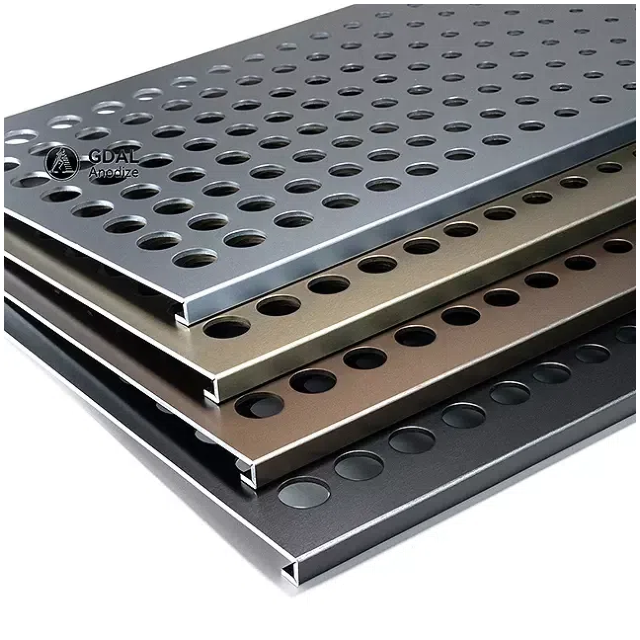- Home
- Products
- OEM&ODM Services
- About
- Applications
- Resources
- Blogs
- Contact
Views: 0 Author: Site Editor Publish Time: 2025-07-04 Origin: Site











For industries ranging from architecture and electronics to transportation and home appliances, anodizing aluminum is more than just a surface treatment—it’s a performance upgrade. But what exactly should you know about anodizing aluminum before choosing it for your application? Whether you're a product designer, engineer, or procurement manager, understanding the fundamentals and advantages of anodizing helps ensure you make the best material decisions. At Guangdong Anlv New Material Co., Ltd., we specialize in producing high-quality anodized aluminum coils and plates, and we believe that informed customers make better, longer-lasting choices. Here are 8 essential things you should know.
There are several anodizing methods, each offering distinct properties for different applications:
Type I (Chromic Acid Anodizing): This method produces a thin, soft oxide layer. It is primarily used in aerospace applications due to its ability to maintain dimensional stability while offering modest corrosion resistance.
Type II (Sulfuric Acid Anodizing): The most common method, it creates a moderate thickness layer suitable for decorative finishes, dyeing, and general corrosion resistance. This is the go-to for most consumer and architectural products.
Type III (Hardcoat Anodizing): Also known as hard anodizing, this method uses higher current densities and longer processing times to create a thick, hard oxide layer. It’s designed for extreme wear and corrosion resistance in industrial and military applications.
At Guangdong Anlv, we specialize in Type II anodizing, offering a perfect balance between aesthetics, durability, and corrosion protection, ideal for decorative and functional uses.
The thickness of the anodic layer varies depending on the anodizing type and the intended use:
Type I: Typically 0.5 to 7 µm
Type II: 5 to 25 µm
Type III: 25 to 100+ µm
The oxide layer thickness affects properties such as scratch resistance, color depth (for dyed finishes), and corrosion performance. A thicker layer means better durability and longer service life, especially in harsh environments.
At Guangdong Anlv New Material Co., Ltd., we control layer thickness to meet customer-specific performance standards, ensuring consistent results across all our anodized aluminum products.
Anodizing aluminum not only strengthens the surface—it also opens up a world of design possibilities:
Organic Dyeing: Uses synthetic dyes to create a wide range of vibrant colors. These are absorbed into the porous anodic layer before sealing.
Electrolytic Coloring: Introduces metal salts into the anodized surface to create metallic tones such as bronze, champagne, or black.
Interference Coloring: Produces iridescent effects through optical interference created by layering the oxide structure.
Metallic Inlays or Combination Finishes: Advanced techniques can also combine etched textures with anodized color for premium visual effects.
At Guangdong Anlv, we offer customizable coloring processes to align with your branding, design, or functional requirements.
Anodized aluminum is extremely resistant to corrosion, thanks to its stable and protective oxide layer. This resistance is especially valuable in:
Marine and coastal environments
Industrial areas with chemical exposure
Outdoor architectural installations
The anodized layer prevents oxidation, pitting, and discoloration that would otherwise degrade the material. Additionally, the sealed surface does not flake or peel like paint, making it low-maintenance over long periods.
With the high-precision anodizing line at Guangdong Anlv, we deliver materials that meet strict international standards for corrosion performance in challenging conditions.
During anodizing, the oxide layer grows both outward and inward:
Outward Growth: Adds to the total part thickness.
Inward Growth (Ingression): Penetrates the original aluminum surface.
Typically, about one-third of the oxide layer thickness penetrates into the aluminum, while two-thirds grow outward. This slight change must be considered when working with tight tolerances.
At Guangdong Anlv, we apply precise controls to accommodate growth factors, ensuring our anodized aluminum sheets and coils retain dimensional integrity for seamless integration into your designs.
One of the most celebrated features of anodizing aluminum is how it enhances durability:
Hardness: The anodic layer is much harder than raw aluminum and comparable to ceramics in hardness.
Scratch Resistance: It can resist physical wear and abrasions that would damage untreated metal.
Wear Resistance: This makes anodized aluminum ideal for high-traffic or mechanically exposed surfaces.
Compared to painted or plated finishes, anodized aluminum performs better over time in both visual and structural quality.
At Guangdong Anlv, our anodized products are engineered for longevity—an investment in reliability and value.
Yes—and positively so. Anodized aluminum is exceptionally easy to clean and requires minimal maintenance:
It doesn’t attract dust or fingerprints easily.
It can be wiped with mild detergent and water—no need for harsh cleaners.
The surface is sealed, non-porous, and resistant to mold or chemical staining.
This low-maintenance quality is especially important in settings like commercial buildings, kitchen interiors, and public transportation, where hygiene and appearance must be maintained over time.
Anodizing is one of the most environmentally responsible surface treatments available:
No Volatile Organic Compounds (VOCs): Unlike painting or coating processes, anodizing doesn’t release harmful emissions into the atmosphere.
Fully Recyclable: Anodized aluminum can be melted and reused without losing its quality or purity.
Non-Toxic: The anodic layer is chemically stable and non-hazardous, making it safe for food contact surfaces and medical equipment.
At Guangdong Anlv New Material Co., Ltd., sustainability is part of our production philosophy. We follow eco-conscious manufacturing practices to reduce waste and environmental impact.

There’s a lot to know about anodizing aluminum, from the different process types and coloring methods to performance enhancements and environmental benefits. Understanding these key aspects empowers you to make the right choices for your product needs—whether you're optimizing for appearance, durability, corrosion resistance, or sustainability.
At Guangdong Anlv New Material Co., Ltd., we are committed to delivering high-quality anodized aluminum solutions tailored to your exact specifications. Our advanced production lines and experienced team ensure consistent, high-performance results every time.
Contact us today to explore how our anodized aluminum plates and coils can elevate your next project with confidence and precision.